tow Citroen C4 PICASSO 2016 2.G Repair Manual
[x] Cancel search | Manufacturer: CITROEN, Model Year: 2016, Model line: C4 PICASSO, Model: Citroen C4 PICASSO 2016 2.GPages: 527, PDF Size: 13.72 MB
Page 292 of 527
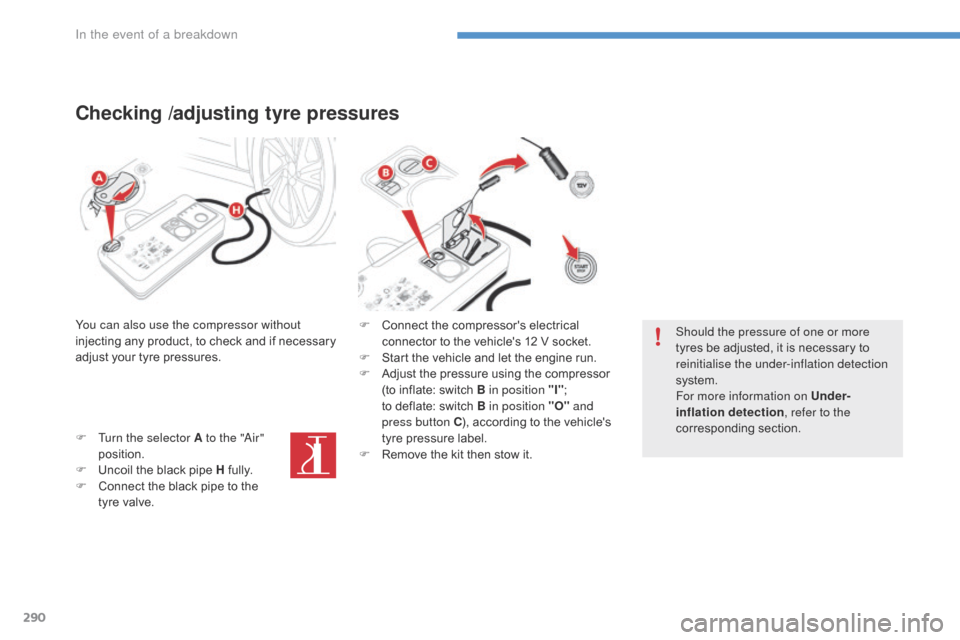
290
C4-Picasso-II_en_Chap08_en-cas-panne_ed01-2016
Checking /adjusting tyre pressures
You can also use the compressor without
injecting any product, to check and if necessary
a
djust your tyre pressures.
F
T
urn the selector A to the "Air"
position.
F
U
ncoil the black pipe H
f
ully.
F
C
onnect the black pipe to the
t
yre valve. F
C onnect the compressor's electrical
c
onnector to the vehicle's 12 V socket.
F
S
tart the vehicle and let the engine run.
F
A
djust the pressure using the compressor
(
to inflate: switch B in position "I";
t
o deflate: switch B in position "O" and
press button C ),
according to the vehicle's
t
yre pressure label.
F
R
emove the kit then stow it.Should the pressure of one or more
tyres
be adjusted, it is necessary to
r
einitialise the under-inflation detection
system.
For more information on Under-
inflation detection , refer to the
corresponding
s
ection.
In the event of a breakdown
Page 294 of 527
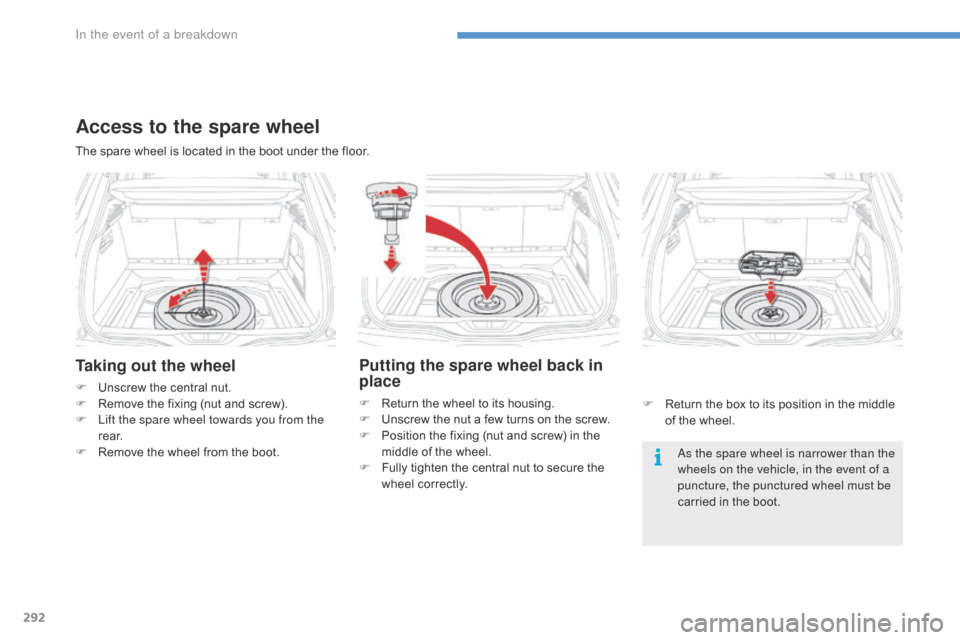
292
C4-Picasso-II_en_Chap08_en-cas-panne_ed01-2016
Taking out the wheel
F Unscrew the central nut.
F R emove the fixing (nut and screw).
F
L
ift the spare wheel towards you from the
r e a r.
F
R
emove the wheel from the boot. As the spare wheel is narrower than the
wheels on the vehicle, in the event of a
puncture, the punctured wheel must be
carried
in the boot.
The
spare wheel is located in the boot under the floor.
Access to the spare wheel
Putting the spare wheel back in
place
F Return
the wheel to its housing.
F U nscrew the nut a few turns on the screw.
F
P
osition the fixing (nut and screw) in the
m
iddle of the wheel.
F
F
ully tighten the central nut to secure the
w
heel correctly. F
R eturn the box to its position in the middle
o
f the wheel.
In the event of a breakdown
Page 295 of 527
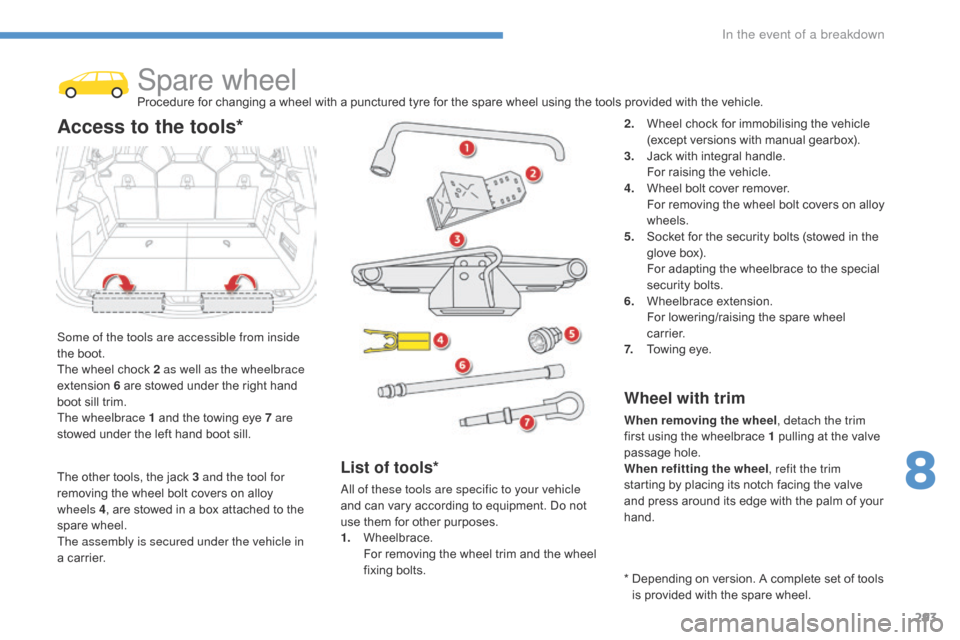
293
C4-Picasso-II_en_Chap08_en-cas-panne_ed01-2016
Spare wheelProcedure for changing a wheel with a punctured tyre for the spare wheel using the tools provided with the vehicle.
S
ome of the tools are accessible from inside
the
boot.
The
wheel
chock 2 as well as the wheelbrace
extension
6
are stowed under the right hand
b
oot
sill
trim.
The wheelbrace 1
and the towing eye 7 are
stowed
under
the left hand boot sill.
Access to the tools*2. Wheel chock for immobilising the vehicle (
except versions with manual gearbox).
3.
J
ack with integral handle.
F
or raising the vehicle.
4.
W
heel bolt cover remover.
F
or removing the wheel bolt covers on alloy
w
heels.
5.
S
ocket for the security bolts (stowed in the
g
love box).
F
or adapting the wheelbrace to the special
s
ecurity bolts.
6.
W
heelbrace
e
xtension.
F
or lowering/raising the spare wheel
c
a r r i e r.
7.
T
owing eye.
Wheel with trim
When removing the wheel , detach the trim
first using the wheelbrace 1 pulling at the valve
p
assage hole.
When refitting the wheel , refit the trim
starting
by placing its notch facing the valve
a
nd press around its edge with the palm of your
han
d.
List of tools*
All of these tools are specific to your vehicle
and can vary according to equipment. Do not
u
se them for other purposes.
1.
W
heelbrace.
F
or removing the wheel trim and the wheel
f
ixing
bol
ts. *
D
epending on version. A complete set of tools
i
s provided with the spare wheel.
The
other
tools,
the
jack
3 and the tool for
removing
the
wheel
bolt
covers
on
alloy
w
heels
4 ,
are
stowed
in
a
box
attached
to
the
spar
e
w
heel.
The assembly is secured under the vehicle in
a
carrier.
8
In the event of a breakdown
Page 297 of 527
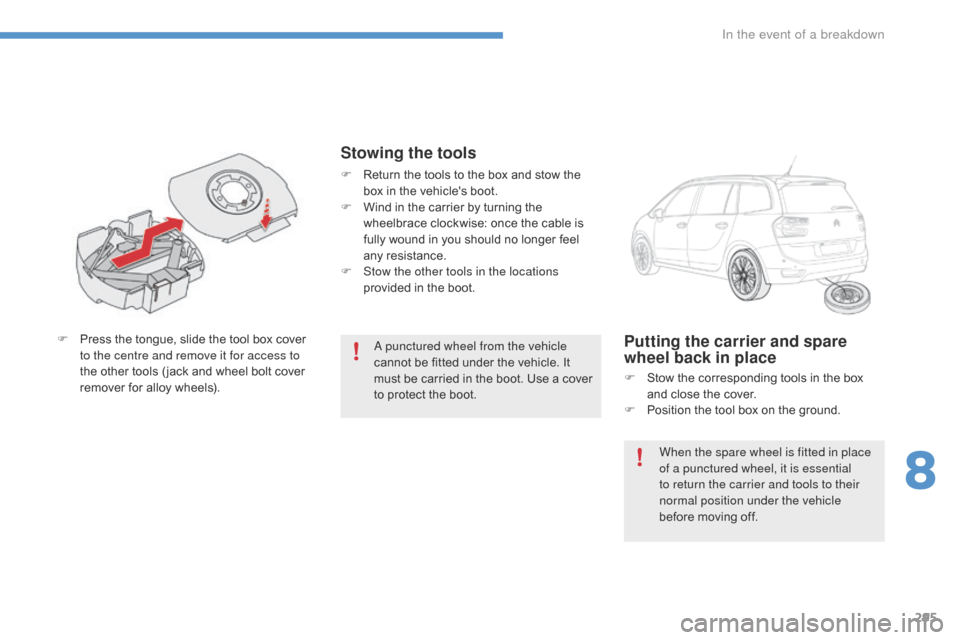
295
C4-Picasso-II_en_Chap08_en-cas-panne_ed01-2016
A punctured wheel from the vehicle
cannot be fitted under the vehicle. It
m
ust
b
e
c
arried
i
n
t
he
b
oot.
U
se
a
c
over
t
o protect the boot.
F
P
ress
the
tongue,
slide
the
tool
box
cover
t
o the centre and remove it for access to
the
other
tools
( jack
and
wheel
bolt
cover
r
emover
for
alloy
wheels).Putting the carrier and spare
wheel back in place
F Stow the corresponding tools in the box a
nd close the cover.
F
P
osition the tool box on the ground.
Stowing the tools
F Return the tools to the box and stow the b
ox in the vehicle's boot.
F
W
ind in the carrier by turning the
w
heelbrace clockwise: once the cable is
f
ully wound in you should no longer feel
an
y
r
esistance.
F
S
tow the other tools in the locations
provided
in the boot.
When the spare wheel is fitted in place
of a punctured wheel, it is essential
to return the carrier and tools to their
normal position under the vehicle
before
moving off.
8
In the event of a breakdown
Page 302 of 527
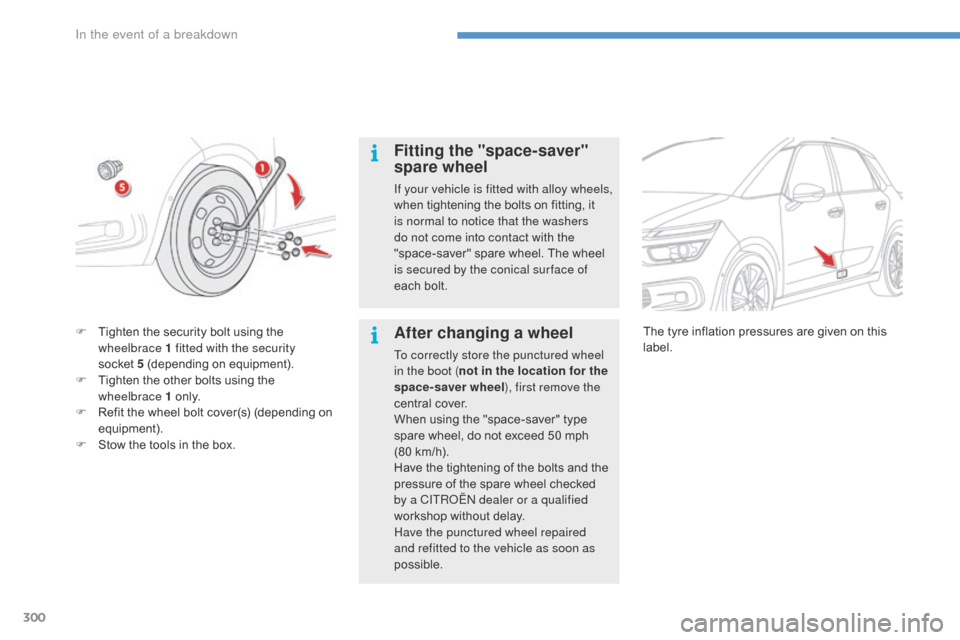
300
C4-Picasso-II_en_Chap08_en-cas-panne_ed01-2016
Fitting the "space-saver"
spare wheel
If your vehicle is fitted with alloy wheels,
when tightening the bolts on fitting, it
i
s normal to notice that the washers
do not come into contact with the
"space-saver"
spare wheel. The wheel
i
s secured by the conical sur face of
each
bolt.
After changing a wheel
To correctly store the punctured wheel
in the boot ( not in the location for the
space-saver wheel ), first remove the
central
cover.
When
using the "space-saver" type
s
pare wheel, do not exceed 50 mph
(
80 km/h).
Have
the tightening of the bolts and the
p
ressure of the spare wheel checked
b
y a CITROËN dealer or a qualified
workshop
without delay.
Have the punctured wheel repaired
and refitted to the vehicle as soon as
possible.
F
T
ighten
the
security
bolt
using
the
w
heelbrace 1 fitted with the security
socket 5
(depending
on
equipment).
F
T
ighten
the
other
bolts
using
the
w
heelbrace 1
o
n l y.
F
R
efit
the
wheel
bolt
cover(s)
(depending
on
e
quipment).
F
S
tow
the
tools
in
the
box. The
tyre inflation pressures are given on this lab
el.
In the event of a breakdown
Page 304 of 527
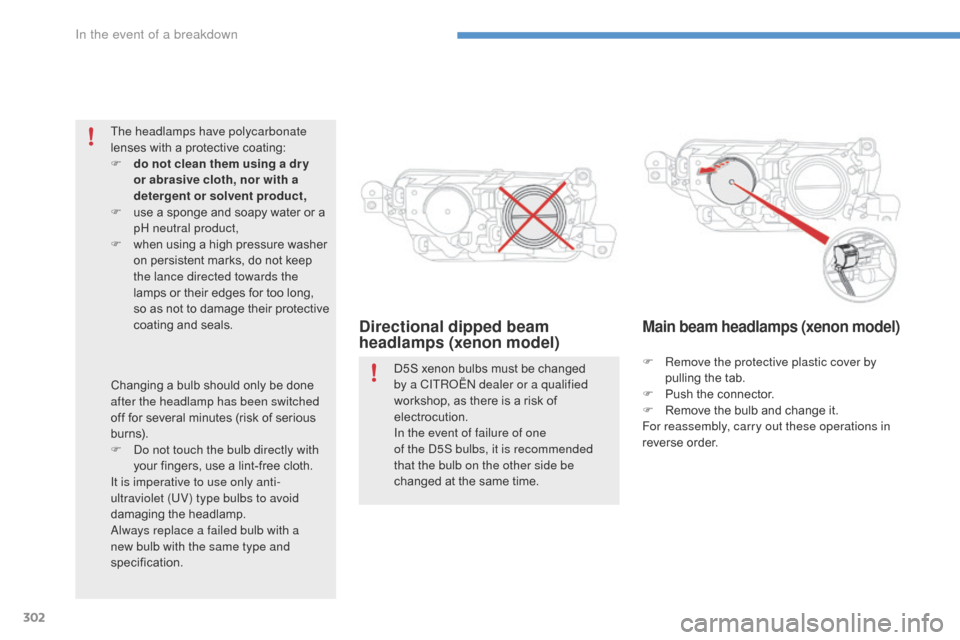
302
C4-Picasso-II_en_Chap08_en-cas-panne_ed01-2016
Directional dipped beam
headlamps (xenon model)Main beam headlamps (xenon model)
F Remove the protective plastic cover by pulling the tab.
F
P
ush the connector.
F
R
emove the bulb and change it.
For reassembly, carry out these operations in
reverse
o
rder.
D5S
xenon
bulbs
must
be
changed
b
y a CITROËN dealer or a qualified
workshop,
as
there
is
a
risk
of
el
ectrocution.
In the event of failure of one
of the D5S bulbs, it is recommended
that the bulb on the other side be
changed
at
the
same
time.
The headlamps have polycarbonate
lenses
with
a
protective
coating:
F
d
o not clean them using a dr y
or abrasive cloth, nor with a
detergent or solvent product,
F
u
se
a
sponge
and
soapy
water
or
a
p
H neutral product,
F
w
hen
using
a
high
pressure
washer
o
n
persistent
marks,
do
not
keep
t
he lance directed towards the
lamps
or
their
edges
for
too
long,
s
o
as
not
to
damage
their
protective
c
oating
a
nd
sea
ls.
Changing
a
bulb
should
only
be
done
a
fter the headlamp has been switched
off
for
several
minutes
(risk
of
serious
b
urns).
F
D
o not touch the bulb directly with
your
fingers,
use
a
lint-free
cloth.
It is imperative to use only anti-
ultraviolet (UV) type bulbs to avoid
damaging
t
he
h
eadlamp.
Always replace a failed bulb with a
new bulb with the same type and
specification.
In the event of a breakdown
Page 316 of 527
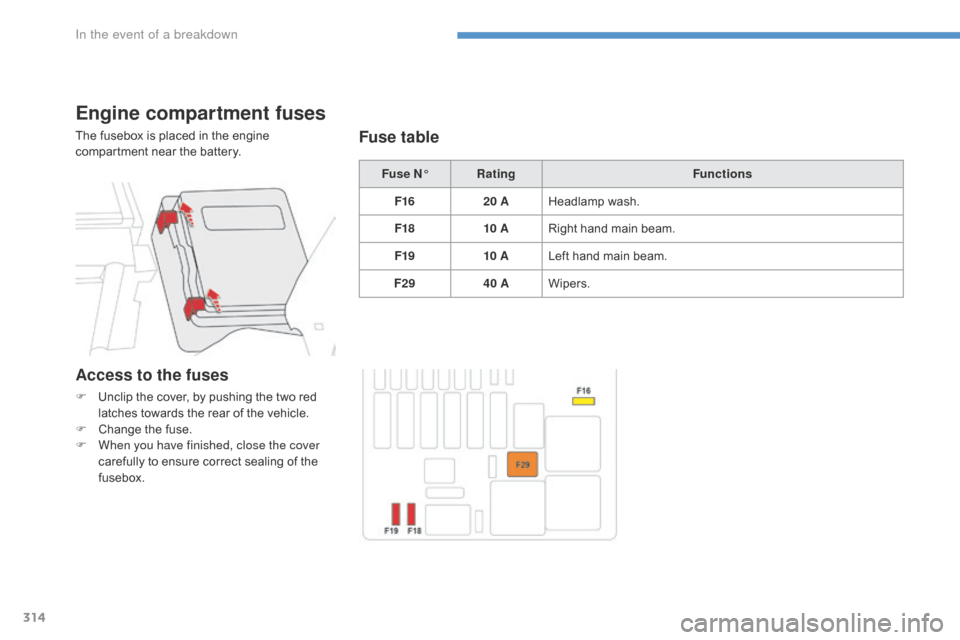
314
C4-Picasso-II_en_Chap08_en-cas-panne_ed01-2016
Engine compartment fuses
The fusebox is placed in the engine compartment near the battery.
Fuse N°Rating Functions
F16 20 AHeadlamp
w
ash.
F18 10 ARight
hand main beam.
F19 10 ALeft
hand main beam.
F29 40 AWipers.Fuse table
Access to the fuses
F Unclip the cover, by pushing the two red l
atches towards the rear of the vehicle.
F
C
hange the fuse.
F
W
hen you have finished, close the cover
carefully
to ensure correct sealing of the
f
usebox.
In the event of a breakdown
Page 321 of 527
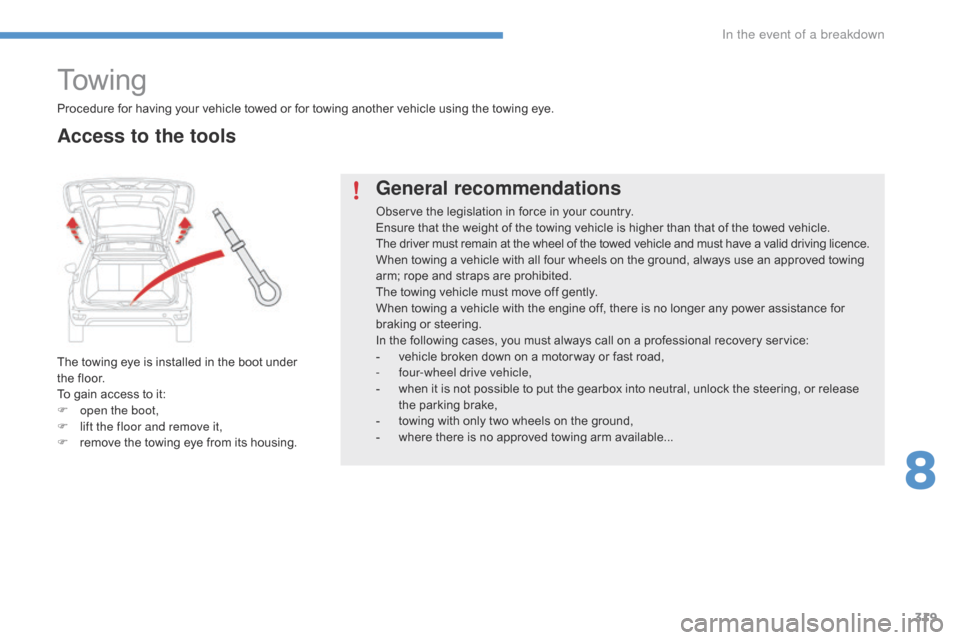
319
C4-Picasso-II_en_Chap08_en-cas-panne_ed01-2016
To w i n g
The towing eye is installed in the boot under the floor.
To
gain access to it:
F
o
pen the boot,
F
l
ift the floor and remove it,
F
r
emove the towing eye from its housing.
General recommendations
Observe the legislation in force in your country.
E nsure that the weight of the towing vehicle is higher than that of the towed vehicle.
The
driver must remain at the wheel of the towed vehicle and must have a valid driving licence.
When
towing a vehicle with all four wheels on the ground, always use an approved towing
a
rm; rope and straps are prohibited.
The
towing vehicle must move off gently.
When
towing a vehicle with the engine off, there is no longer any power assistance for
b
raking or steering.
In
the following cases, you must always call on a professional recovery service:
-
v
ehicle broken down on a motor way or fast road,
-
f
our-wheel drive vehicle,
-
w
hen it is not possible to put the gearbox into neutral, unlock the steering, or release
t
he parking brake,
-
t
owing with only two wheels on the ground,
-
w
here there is no approved towing arm available...
Procedure
for
having
your
vehicle
towed
or
for
towing
another vehicle using the towing eye.
Access to the tools
8
In the event of a breakdown
Page 322 of 527
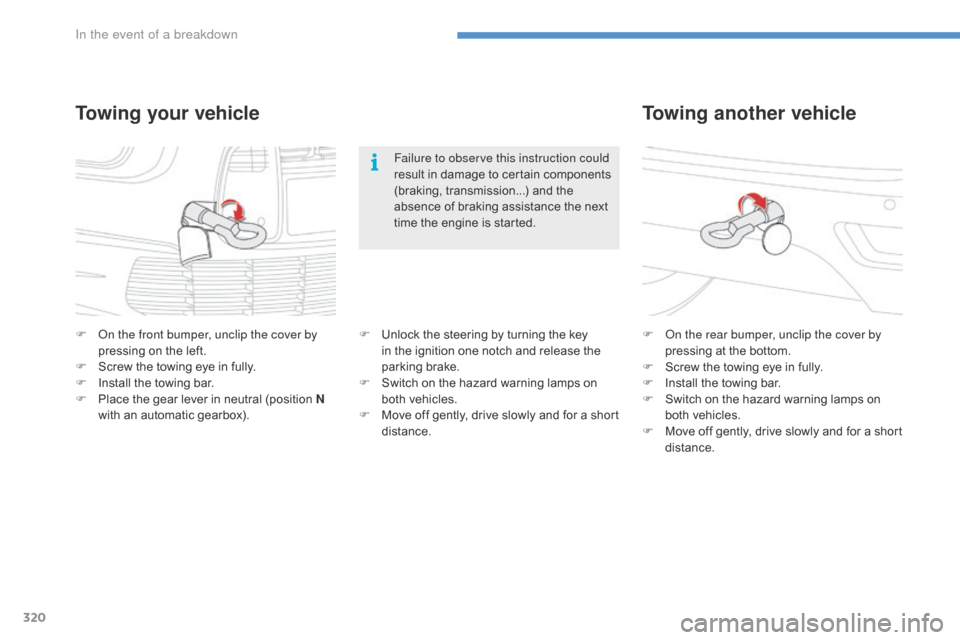
320
C4-Picasso-II_en_Chap08_en-cas-panne_ed01-2016
Towing another vehicle
F On the rear bumper, unclip the cover by pressing at the bottom.
F
S
crew the towing eye in fully.
F
I
nstall the towing bar.
F
S
witch on the hazard warning lamps on
b
oth vehicles.
F
M
ove off gently, drive slowly and for a short
di
stance.
F
O
n the front bumper, unclip the cover by
pressing
on
the
left.
F
S
crew
the
towing
eye
in
fully.
F
I
nstall
the
towing
bar.
F
P
lace
the
gear
lever
in
neutral
(position
N
with
an
automatic
gearbox).
Towing your vehicle
Failure to observe this instruction could
result in damage to certain components
(
braking, transmission...) and the
a
bsence of braking assistance the next
t
ime the engine is started.
F
U
nlock the steering by turning the key
i
n
the ignition one notch and release the
par
king
b
rake.
F
S
witch on the hazard warning lamps on
b
oth vehicles.
F
M
ove off gently, drive slowly and for a short
di
stance.
In the event of a breakdown
Page 326 of 527
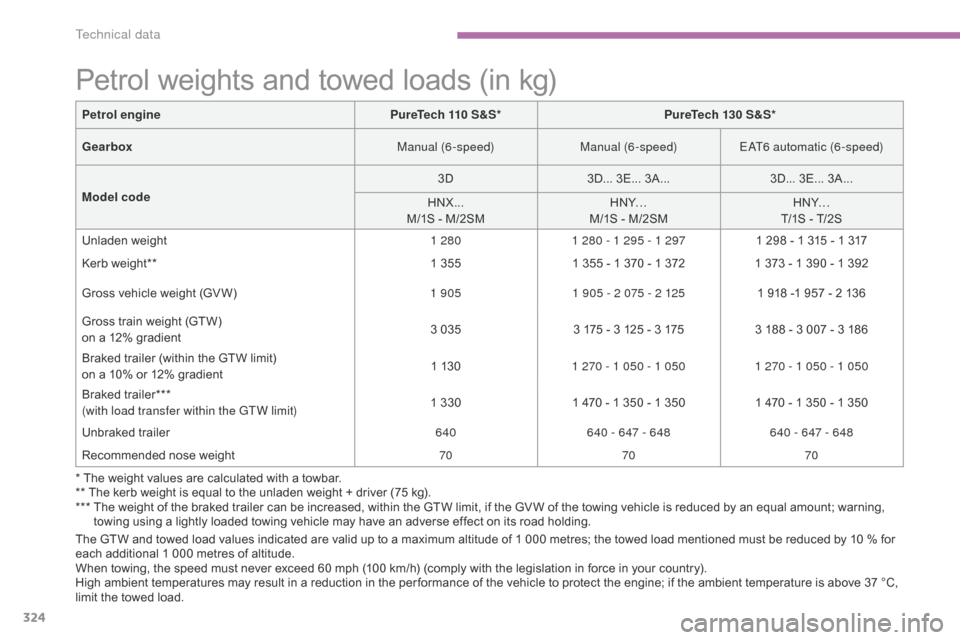
324
C4-Picasso-II_en_Chap09_caracteristiques-techniques_ed01-2016
* The weight values are calculated with a towbar.
* * The kerb weight is equal to the unladen weight + driver (75 kg).
***
T
he weight of the braked trailer can be increased, within the GTW limit, if the GV W of the towing vehicle is reduced by an equal amount; warning,
t
owing using a lightly loaded towing vehicle may have an adverse effect on its road holding.
Petrol engine
PureTech 110 S&S*PureTech 130 S&S*
Gearbox Manual (6-speed)Manual (6-speed)EAT6 automatic (6-speed)
Model code 3D
3D...
3
E...
3
A...
3D...
3
E...
3
A...
HNX...
M/1S - M/2SM
HNY…
M/1S - M/2SM
HNY…
T/1S - T/2S
Unladen weight
1 2801 280 - 1 295 - 1 297 1 298 - 1 315 - 1 317
Kerb weight**
1 355
1 355 - 1 370 - 1 372
1 373 - 1 390 - 1 392
Gross vehicle weight (GV W)
1 9051 905 - 2 075 - 2 125 1 918 -1 957 - 2 136
Gross train weight (GTW)
o
n a 12% gradient
3 035
3 175 - 3 125 - 3 175
3 188 - 3 007 - 3 186
Braked trailer (within the GTW limit)
o
n a 10% or 12% gradient
1 130
1 270 - 1 050 - 1 050 1 270 - 1 050 - 1 050
Braked trailer***
(with load transfer within the GTW limit) 1 330
1 470 - 1 350 - 1 350
1 470 - 1 350 - 1 350
Unbraked
t
railer
640640 - 647 - 648 640 - 647 - 648
Recommended nose weight
707070
Petrol weights and towed loads (in kg)
The GTW and towed load values indicated are valid up to a maximum altitude of 1 000 metres; the towed load mentioned must be reduced by 10 % for e
ach additional 1 000 metres of altitude.
When
towing, the speed must never exceed 60 mph (100 km/h) (comply with the legislation in force in your country).
High
ambient temperatures may result in a reduction in the per formance of the vehicle to protect the engine; if the ambient temperature is above 37 °C,
l
imit the towed load.
Technical data